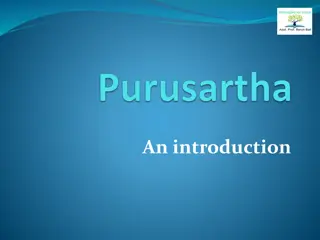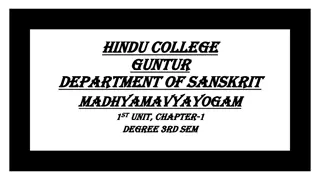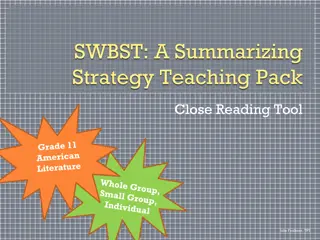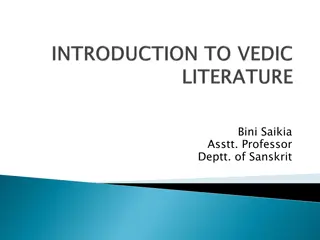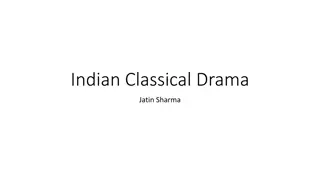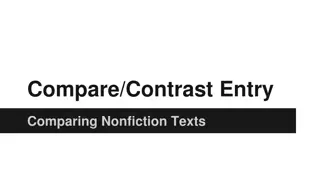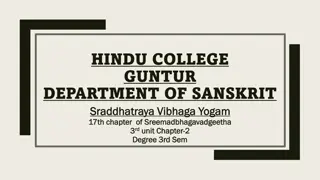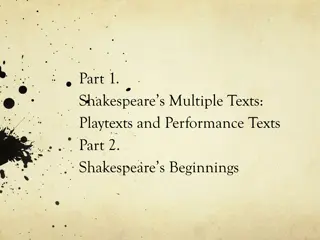Together with Best Question Bank for Class 9 CBSE 2024 Sanskrit (Shemushi) for n
Best Question Bank for Class 9 Sanskrit (Shemushi) for Session 2024-25 has been released. Question Bank for Class 9 CBSE 2024 based on latest syllabus includes Section-wise MCQs and Important Terms, Practice Questions, Practice Papers, Completely Solved NCERT Textbook Exercises and much more, Get co
0 views • 1 slides
Understanding Inference and Vyapti in Logic
Inference, known as Anumana in Sanskrit, is the process of deriving knowledge based on existing information or observations. It can be used for personal understanding or to demonstrate truths to others. An inference may be SvArtha (for oneself) or ParArtha (for others). Vyapti, the invariable concom
1 views • 14 slides
Biography and Works of Kalidasa: The Great Poet of Ancient India
Kalidasa, the revered poet of ancient India, is celebrated for his significant contributions to Sanskrit literature. Known for works like "Abhignana Sakuntalam" and "Raghuvamsam," Kalidasa's life and poetic genius continue to inspire scholars and enthusiasts alike. This biography explores his origin
5 views • 16 slides
Enhancing Language Skills Through Challenging Literary Texts
Broaden vocabulary, reactivate knowledge, and engage emotionally with challenging literary texts to develop comprehension strategies, cultural awareness, and cognitive skills. Utilize various media sources and explicit instruction to access more complex texts, fostering creativity and cross-curricul
4 views • 28 slides
Understanding Purusharthas: The Four Goals of Human Life
Purushartha, derived from Sanskrit, encompasses the four life goals of dharma (duty), artha (prosperity), kama (pleasure), and moksha (liberation). Dharma, the foundation, guides the pursuit of the other goals leading to spiritual fulfillment. While dharma is considered paramount, moksha is ideal, e
6 views • 17 slides
Prarthana Samaj
Prarthana Samaj, meaning "Prayer Society" in Sanskrit, was founded in 1867 by Atmaram Pandurang with the objective of promoting belief in one God and advocating worship of the same. The movement gained traction when Mahadev Govind Ranade joined, with intellectuals advocating social system reforms. I
5 views • 12 slides
Understanding Critical Stylistics: Tools and Application
Critical Stylistics (CS) is a method that delves into the ideological underpinnings of texts through the analysis of linguistic features. Developed by Jeffries, CS focuses on uncovering implicit ideologies embedded in texts by examining stylistic choices. By integrating stylistics and critical disco
2 views • 28 slides
Origin and Development of Indian Drama in English
Indian English Drama has a rich history, starting from the Sanskrit plays of the Vedic Age to prominent playwrights like Rabindranath Tagore and Sri Aurobindo Ghosh. The genre saw a resurgence in the 20th century with significant contributions from various playwrights marking its evolution through s
0 views • 8 slides
Exploring Texts, Culture, and Value Through Appropriation
In Year 11 Extension 1, students delve into texts from the past and their influence on present culture. They analyze the relationships between texts and culture, language's impact on values, and different responses to texts. Through close study, they explore key texts from the past, examining how th
0 views • 9 slides
Indian Theories of Communication: Understanding Sadharanikaran
Indian communication theories have deep roots in religious literature and fine arts, with concepts like Sadharanikaran emphasizing mutual understanding and commonness. This Sanskrit term reflects the essence of communication as a relationship based on shared feelings and culture, rather than persuas
1 views • 8 slides
Understanding Representation in Media Studies
Representation in media studies refers to how aspects of society such as gender, age, ethnicity, and identity are presented to audiences through media texts. These texts have the power to influence ideas and attitudes by shaping the audience's understanding of important topics. Analyzing media texts
1 views • 19 slides
Evolution of Inscriptions in Ancient Indian History
The evolution of inscriptions in ancient India reflects a shift from Prakrit to Sanskrit languages over the centuries, marking changes in content, purpose, and classification. Beginning with Brahmi inscriptions, the transition to Sanskrit gradually replaced Prakrit as the language of choice in North
0 views • 12 slides
Introduction to the Sanskrit Drama "Madhyama Vyayoga
A Brahmin named Kesavadas and his family encounter the demoness Hidimba's son Ghatotkacha while traveling to his cousin's thread ceremony. Mistaking Ghatotkacha for the God of Death, they seek help from the Pandavas who are residing nearby. Ghatotkacha tries to assure them of no harm, but the family
0 views • 11 slides
Exploring Historicism and New Historicism: Perspectives on History and Literature
Understanding Historicism and New Historicism, this article delves into their definitions, perspectives on history, treatment of literary and non-literary texts, examples, and the emergence of New Historicism in the 1980s. It explores how these approaches unify cultural and social texts, challenge t
0 views • 16 slides
SWBST Summarizing Strategy Teaching Pack Overview
SWBST is a summarizing strategy designed by Julie Faulkner to help readers comprehend texts effectively. It entails breaking down texts into key components: Somebody (main character/speaker/author) Wanted (motivation), But (problem/conflict), So (solution), Then (resolution). The strategy aids in hi
0 views • 18 slides
Comparative Hermeneutics: Understanding Biblical Texts
Explore the application of hermeneutical methods on biblical texts such as Psalm 23 and 1 Tim. 2 through interpretation, translation, and contextual analysis. Delve into the meaning of texts, the role of signs and symbols, and the impact of varying presuppositions on interpretation. Reflect on the p
0 views • 46 slides
Panini Maharshi: The Foremost Grammarian of Sanskrit Language
Panini Maharshi, the first and foremost grammarian of the Sanskrit language, is best known for his work Asthadhayai, a book on grammar which is highly revered among scholars and learners. His scholarly approach and foundational work in grammar have made him a prominent figure in linguistic studies.
4 views • 10 slides
GCSE English Literature Exam Overview
This overview provides information on the GCSE English Literature exam structure, content, and assessment objectives for both components. It includes details on the texts studied, such as Shakespeare, poetry, post-1914 prose/drama, and 19th-century prose. Students are assessed on their ability to re
0 views • 23 slides
Devotion and Learning: Vandana in Sanskrit - Lesson 1 at I.B. Patel English School
Explore the essence of devotion and learning in Sanskrit with Lesson 1 at I.B. Patel English School. Dive into prayers to Goddess Saraswati, the significance of Sanskrit as the mother language, and invoking blessings for health, wealth, and wisdom.
0 views • 10 slides
Exploring the Vedas: Ancient Sanskrit Texts and Their Divisions
Diving into the roots of knowledge, the Vedas are ancient texts derived from the root meaning 'to know'. Various synonymous terms like ruti, tray vidya, gama, and chandas are used to describe these sacred scriptures. The Vedas consist of four main divisions - Rigveda, Samaveda, Yajurveda, and Atharv
0 views • 14 slides
Ancient Civilizations Studies and Group Activities
Explore the similarities between Mesopotamia and Ancient Egypt, make predictions about another ancient civilization, engage in group activities like reading chapters, answering questions, and playing Vocab Alive. Learn about key terms like Monsoon, Sanskrit, Caste System, and more. Collaborate in sm
0 views • 33 slides
Insights into Indian Classical Drama and Literature
Explore the rich tradition of Indian classical drama and literature, from its origins in Ujjain during the Gupta period to the classification of major and minor dramas. Learn about the components of a classical Sanskrit drama, such as the plot, characters, sentiments, acting, and more. Delve into th
1 views • 9 slides
Hindu Upanayana Ceremony Explained
The Upanayana ceremony, also known as the Sacred Thread ritual, is a significant Hindu rite of passage for boys, akin to the Hindu Bar Mitzvah. It symbolizes the transition to youth and the beginning of a quest for knowledge of sacred scriptures. Over a two to three-day period, the ceremony includes
0 views • 15 slides
Literature Assessment: Understanding Modern Texts and Poetry
This assessment focuses on modern texts, poetry, and unseen poetry, evaluating students' ability to analyze literary works and demonstrate understanding. Students must be prepared to write essays and respond to various types of questions within a time limit. Key areas covered include Sheila's charac
0 views • 16 slides
Analyzing Nonfiction Texts: Comparing Structures and Evidence
Explore how two nonfiction texts, "Watch Your Driving, Kids" and an Allstate Foundation video, present statistics on teen car crashes and propose solutions. Dive into the authors' text organization and credibility, unveiling similarities in the texts' structures and evidence presentation.
0 views • 10 slides
Understanding Procedure Texts and their Structure
Procedure texts are instructional pieces of writing that explain how something works or how to perform a specific activity. They typically consist of three main definitions: texts that explain how to use something, texts that provide instructions for a particular activity, and texts that address hum
0 views • 10 slides
The Uniqueness of Sanskrit: A Cultural Journey Through Non-Translatability
Explore the depth of Sanskrit language and culture, delving into the significance of non-translatability. Discover how Sanskrit mantras hold the essence of creation and resistance against colonization, emphasizing the vibrational power within. Immerse yourself in the holistic experience of ancient w
0 views • 39 slides
Exploring Philosophy: The Love of Wisdom and Fundamental Questions
Delve into the world of philosophy with a focus on the love of wisdom. Explore the basic questions of reality, value, and knowledge. Uncover the branches of philosophy and concepts like metaphysics, epistemology, and axiology. Understand the Greek and Sanskrit roots of philosophical terms and their
0 views • 16 slides
Understanding Rasa Theory in Indian Theatrical Arts
Explore the significance of Rasa theory in Indian theatrical arts as outlined in the Natya Shastra, an ancient treatise on performing arts. Discover how bhavas create rasas, evoking emotions in the audience and transporting them to a parallel world of wonder and reflection. Learn about the historica
0 views • 18 slides
Understanding Devanagari Sanskrit Writing System
Explore the beauty and complexity of the Devanagari writing system used for Sanskrit and other Indic languages. Learn about its unique order of letters, aspirates, phonemes, and intricate vowel structures. Discover why Devanagari is a fascinating script to study and appreciate.
0 views • 8 slides
Heartwarming Appeal for Help in Sanskrit Poetic Verses
Poetic verses in Sanskrit language convey a heartfelt appeal for assistance and support. The verses express a deep yearning for aid and kindness, appealing to the emotions of the readers. The evocative language and poignant imagery enhance the emotional impact of the message, inviting empathy and un
0 views • 35 slides
Understanding the Various Purposes of Texts
Explore the diverse functions of texts and how they convey meaning, from spooky holiday advertisements to cooking instructions and flu immunization details. Discover how language and textual features are used to achieve different purposes, and learn to identify implicit meanings in texts. Enhance yo
0 views • 9 slides
Enhancing Information Texts with Non-Finite Subordinate Clauses
Providing layers of detail in information texts involves using non-finite subordinate clauses to establish connections between grammar, meaning, and rhetorical effects. The LEAD principles emphasize linking grammar to writing purposefully, using authentic texts as models, and fostering deep metaling
0 views • 8 slides
Enhancing Reading Skills: Comparing Texts for English Learners
Enhance your English reading skills by comparing texts to identify similarities and differences. Practice analyzing information, ideas, and opinions in different texts, including how they are conveyed. This resource provides exercises and examples to help you develop your ability to compare and cont
0 views • 14 slides
Hindu College Guntur Department of Sanskrit - Sraddhatraya Vibhaga Yogam Introduction
The introduction provides insights into the department of Sanskrit at Hindu College Guntur, highlighting the significance of Sraddhatraya Vibhaga Yogam and the 17th chapter of the Sreemadbhagavadgeetha. It explores the role of Vyasa in Hindu traditions and his association with the Mahabharata, shedd
0 views • 10 slides
Analysis of Word Choices and Attitudes in Literary Texts
The provided content delves into the representation of characters through word choice and attitudes in various literary texts. It examines the implications behind phrases like "dark, competent hands" and "Mandy got her degree, did she? Dog my cats", shedding light on underlying biases and perspectiv
0 views • 16 slides
Translation of Legal Texts Course Overview
This course provides a comprehensive overview of translating legal texts from English into Arabic and vice versa. Students will explore various types of legal texts, specialized terminology, and resources essential for accurate translation. The course covers the history of legal discourse, emphasizi
0 views • 50 slides
Understanding Shakespeare's Playtexts and Performance Texts
Dive into Shakespeare's world of multiple texts, exploring the nuances between playtexts and performance texts. Discover the collaborative nature of early modern playwriting and the significance of deciphering performance elements in comprehending his works. Unveil the intersection of written words
0 views • 9 slides
Julia Kristeva & the Theory of Intertextuality: An Introduction
In this introduction to Julia Kristeva's theory of intertextuality, we explore her concept of texts as intersections of various writings rather than fixed points of meaning. Kristeva argues that texts are composed of prior existences, forming a mosaic of quotations and transformations. Intertextuali
0 views • 25 slides
Exam Rubric and Guidelines for European Theatre Module
The content discusses important information regarding the exam rubric for the European Theatre module, including guidelines on time limits, permitted topics, penalties for violations, and advice on handling exam questions. It clarifies rules on writing about the same texts as in coursework essays, s
0 views • 29 slides




